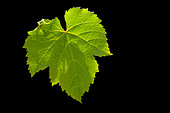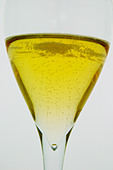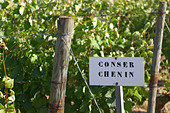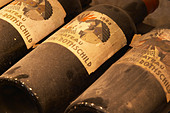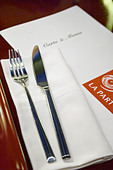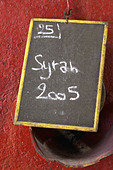 We recently had the opportunity to meet with the winemaker from Vina Maipo, and taste some of his wines, when both he and BKWine happened to be on a flash visit to Stockholm at the same time. Max Weinlaub was in Sweden to launch the Gran Devoción range of wines (and BKWine was there to meet with book and magazine publishers). All red Gran Devoción is made from syrah, Winelaubs favourite grape, blended with cabernet sauvignon, carmenère or petite sirah. The white version is made from sauvignon blanc, a grape that Max Weinlaub thinks has great potential in Chile. “Consumers want wines with more freshness, without oak, which is what they get if they buy a sauvignon blanc”, he says. For the Gran Devoción he sources the sauvignon blanc from the western parts of Casablanca where the climate is cool.
We recently had the opportunity to meet with the winemaker from Vina Maipo, and taste some of his wines, when both he and BKWine happened to be on a flash visit to Stockholm at the same time. Max Weinlaub was in Sweden to launch the Gran Devoción range of wines (and BKWine was there to meet with book and magazine publishers). All red Gran Devoción is made from syrah, Winelaubs favourite grape, blended with cabernet sauvignon, carmenère or petite sirah. The white version is made from sauvignon blanc, a grape that Max Weinlaub thinks has great potential in Chile. “Consumers want wines with more freshness, without oak, which is what they get if they buy a sauvignon blanc”, he says. For the Gran Devoción he sources the sauvignon blanc from the western parts of Casablanca where the climate is cool.
Max’s ambition is that Vina Maipo will become a leader in Chile for syrah. There are today some 4500 ha syrah plantations and Vina Maipo has 183 ha. “In a very short time syrah has reached very good quality levels in Chile”, says Max. For the Gran Devoción it gives liveliness to the wines and red fruit and delicate acidity. “Since carmenère is harvested late the pH can become rather high, sometimes 4 or more, and then it is good to blend it with syrah that adds acidity”.
Four years ago Maipo started to plant some petite sirah and now they have 6 ha of this unusual variety otherwise mostly seen in California. “It’s an interesting crossing between syrah and peloursin”, says Max, “and it gives interesting aromas of dark fruit, tar, and black pepper. An in addition I thought it was fun to bring together syrah and petite sirah”.
Gran Devoción Cabernet Sauvignon Syrah 2007 is made from 85% cabernet and 15% syrah. Its dark colour comes from the very big temperature difference between day and night in Maule, Max explains. “That gives intense colour as well as round tannins”. The oak is present but well integrated which is exactly what Max strives for. He wants to have a lot of fruit and to keep the oak in the background; a good structure but no harsh tannins; a good acidity and not too much alcohol, which is not always easy in Chile.
 Max also has other interesting projects in the pipeline concerning grape varieties from the south of France. He is a great believer in grenache which he thinks will be his next project. “The grenache wines made in Chile today are not very good, we have the potential to make much better”, he says. He also thinks carignan can have potential to become interesting in Chile. “Carignan came to Chile many years ago and it was blended with país (another variety) to give it a bit more body. So now you can find 80 year old carignan vines, beautiful old gobelet on good soil since it often was poor farmers who planted it and they did not have the money for fertilizer. Today the wine producers are very happy to work with these old vineyards”. It sounds familiar, doesn’t it? Just like the story in the Languedoc.
Max also has other interesting projects in the pipeline concerning grape varieties from the south of France. He is a great believer in grenache which he thinks will be his next project. “The grenache wines made in Chile today are not very good, we have the potential to make much better”, he says. He also thinks carignan can have potential to become interesting in Chile. “Carignan came to Chile many years ago and it was blended with país (another variety) to give it a bit more body. So now you can find 80 year old carignan vines, beautiful old gobelet on good soil since it often was poor farmers who planted it and they did not have the money for fertilizer. Today the wine producers are very happy to work with these old vineyards”. It sounds familiar, doesn’t it? Just like the story in the Languedoc.
There are several wines in the Grand Devoción range. We tasted: Sauvignon Blanc 2007 (99 SEK in Sweden), with a good body and acidity, quite complex. The aromatic varietal character is slightly muted compared to Maipo’s cheaper Reserva SB. Cabernet Sauvignon/Syrah 2007 (99 SEK): Dominated by dark fruit with oak in the background (30% new barrels). Soft, rounded tannins and ripe fruit with a hint of chocolate. Quire delicious. Limited Edition syrah 2007 (149 SEK): Good fruit and tannins giving a good structure to the wine, yet a wine with sunshine in the flavour where the fruit dominates. Very pleasant.
Have you tasted Vina Maipo Gran Devocion? What did you think?
Read more...
 Pencil in January 24 to 26 if you are interested in organic wine. That are the dates for the next edition of Millésime Bio, the wine fair dedicated to organic wine producers (and also including a number of biodynamic wine producers). Compared to e.g. Vinexpo or ProWein it is of very manageable size – and the exhibitors are primarily small, family owned producers. The wine show is primarily for professionals. An excellent occasion to find new suppliers. 24-26 January 2011 in Montpellier in the south of France. More info www.millesime-bio.com
Pencil in January 24 to 26 if you are interested in organic wine. That are the dates for the next edition of Millésime Bio, the wine fair dedicated to organic wine producers (and also including a number of biodynamic wine producers). Compared to e.g. Vinexpo or ProWein it is of very manageable size – and the exhibitors are primarily small, family owned producers. The wine show is primarily for professionals. An excellent occasion to find new suppliers. 24-26 January 2011 in Montpellier in the south of France. More info www.millesime-bio.com















